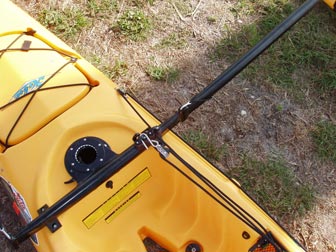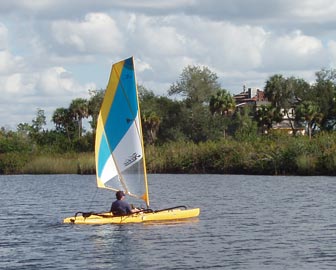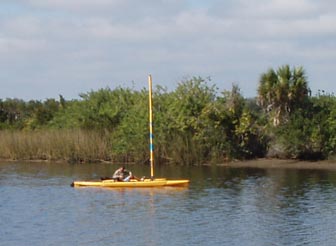Sailing / Paddling / Pedaling the Hobie Mirage Adventure Island
 The akas attach to crossbeams with a single pin
The akas attach to crossbeams with a single pinHis and Hers Reviews — His Review
- See Her Review
Sailing the Hobie Adventure Island trimaran "Sail/Yak" is a pure sailing thrill! Just roll out the sail and you are coasting along at speeds that would require vigorous paddling in a normal kayak. Quickly accelerating to 4 or 5 knots while sitting so low in the water makes it seem like the boat is going much faster.
Sailing my Klepper kayak requires a good deal of "body English" as I lean far out over the coaming and put my elbow on the upwind side of the hull to help stabilize the boat. The trimaran configuration on the Hobie Adventure Island makes all that unnecessary. Just sit and sail, steering with your left hand and managing the mainsheet with your right. Even in fairly strong gusts, the boat does not heel over much at all, not even burying an ama most of the time. You can stand up in the boat and remove the mast with no trouble.
Assembling & Rigging the Adventure Island
The boat was quick and easy to assemble and rig. The 4 akas attach to the crossbeams with single pins, and their ends are inserted into holes in the amas and held in place by a bungee. Two support struts from the rear akas snap onto the hull sides with a ball and socket type joint to hold the hulls out. If you want to swing them in, just pull the strut off and they swing back alongside the main hull and are held in place with a bungee.
The mast is inserted through the deck to rest on a pin. A locking device holds it down, and it releases with a small trigger lever at the mast base. Once the mast is in place, just attach the mainsheet-outhaul to the clew of the sail and run the furling line from the drum at the mast base to the cam cleat, and the Adventure Island is ready to sail.
 The Adventure Island is well-balanced on a reach.
The Adventure Island is well-balanced on a reach.Sailing the Adventure Island
The easy way to set the sail is to simply reach up and grab the clew with your hand and pull on it, using the other hand to take up the slack in the mainsheet. If it is windy, it is a better idea to pull the mainsheet with one hand while slowly letting out the furling line with the other hand. You can stop letting out the furling line when you have enough sail unrolled for the wind conditions and point of sail.
I found that pedaling with the MirageDrive helped maintain boat speed when the wind slacked off, and it was nice to be able to pedal a few strokes to power the boat through a tack without losing any speed. Without assistance from the MirageDrive, the boat tacked through 110 degrees, but a little pedaling significantly narrows that angle. The daggerboard did not seem effective at preventing side-slippage at low speeds, but with a little speed, the boat tracked straight. Pedaling a bit when sailing upwind almost eliminated slippage.
Reaching
Sailing on a reach with the Adventure Island, the power of the sail is easily balanced by the ama, and the minimal resistance of the kayak hull and the downwind ama result in quick acceleration and good speed. If you feel like sailing, the boat is quite responsive to small changes in sail trim as the wind speed and angle changes, so you can sit there and endlessly tweak the sail to try to maximize speed. If you feel like relaxing, the Adventure Island has two drink holders, and you can just set the sail and coast along.
Running Downwind
On a downwind run, the Adventure Island performs well if the wind is fairly strong and steady, but the lack of a boom means that it is hard to keep the sail out and filled on a run in light air. The boat could benefit from a light line run from the clew to the aft end of each ama to help pull the sail out to the side. It would make rigging and sailing a bit more complicated, but could add significantly to downwind performance. Because there are no shrouds to prevent letting the sail out beyond 90 degrees, it is possible to just keep letting it out and sail by the lee, and having an extra control line out at the corner of the boat would make that easier as well. It would be a good idea to build a weak link into such a line so that if there are strong loads in an accidental jibe the boat is not damaged. I doubt that Hobie designers intended for us to use the sail to tug on the aft end of the ama, but sailors must tweak and modify.
Sailors also feel a compulsion to add sail area, at least in this part of the world, where winds are often light. The Adventure Island's light weight and low drag allows it to move well in light air, but wouldn't it move a bit better if I could just figure out a way to add a jib up there? And maybe a bowsprit to allow a BIGGER jib or a spinnaker? I'll just need to devise some kind of a swivel in the top of the mast... nah, maybe I'd better not.
- Note: A few months later, I couldn't help myself. I took an old jib I had from a boat I no longer have, and made a jib for my Adventure Island. You can read about adding a jib to the Adventure Island here.
 The sail furls easily.
The sail furls easily.Furling the Sail
The large roller bearing mast base and drum make furling the sail easy — just ease the mainsheet and pull the furling line, and the sail rolls around the mast. There is a small line and a jam cleat sewn into the sail so that you can secure the rolled sail easily when you disconnect the mainsheet and furling line to remove the mast from the boat.
Paddling the Adventure Island
With the ready and easy power of the MirageDrive and the fun of the sail, I almost forgot to try paddling the Adventure Island the first time I took it out. When I did remember to pick up the paddle, I found that my strokes were somewhat constricted by the akas. The boat moved pretty well with short "cruising" paddle strokes, but with the extra resistance of the two amas and the mast, I would not want to paddle very far into a strong wind and chop. Using the paddle to assist the MirageDrive would work very well in those conditions, once you get the feel of paddling while pedaling.
I can see lots of fun in my future with a Hobie Adventure Island kayak.
2012 Update: still enjoying the boats! Here is a short video:
- See Her Review
Hi, This s a great article. I test sailed one of these units at Geelong this weekend & had to take it out a 2nd time to try a stronger wind as I have enjoyed flying cat hulls in the past. I am very seriously considering purchasing one but wish also to look at the possibility of fitting a jib. I like the idea of rigging a main sheet from the rear of the outriggers. I found a video of a test sail of one of these units with a jib in use!!! I guess it is not publicised due to the need for design changes. I like speed!!!
It is a great boat & answeres the problem for a caravaner who wishes to “roof-top” a sail boat with ease.
Hook
I love my Hobie, purchased in July,2008! I’ve capsized twice in high wind & choppy conditions on the Oakland Estuary, which leads from San Francisco Bay. Both times were my fault: #1 I went out with the crossbar not secured and #2 I didn’t reef properly. First time, my Hubby helped me right it in the dinghy. Second time, he helped me right it while he was in his Lazer! (Yes his Lazer is faster!) I do love the stability of the Hobie Island, but I’d like to get a deeper daggerboard & rudder, an a longer tiller extension. I’ve learned to secure the daggerboard having lost 2 during capsize.
FOR SAILING DOWNWIND I have fixed a small plastic lacing/lashing hook to the top of each rear ama and facing forward- app 32″out from the pin securing the ama. I find it is very quick when turning to run downwind to slacken the mainsail sheet, reach out with it and run it behind the stabiliser arm clip and then hook it behind the lacing hook. This allows adjustment to the sheet and keeps the mainsail out a bit further than arms-length, and unhooks almost instantly.